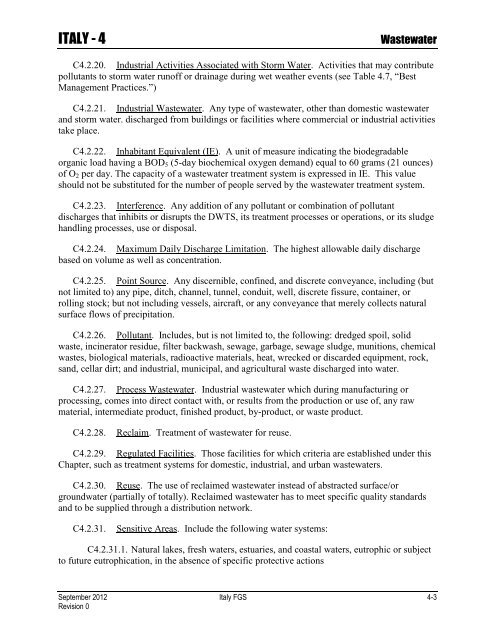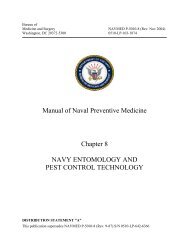ENVIRONMENTAL FINAL GOVERNING STANDARDS ITALY
ENVIRONMENTAL FINAL GOVERNING STANDARDS ITALY
ENVIRONMENTAL FINAL GOVERNING STANDARDS ITALY
Create successful ePaper yourself
Turn your PDF publications into a flip-book with our unique Google optimized e-Paper software.
<strong>ITALY</strong> - 4 Wastewater<br />
C4.2.20. Industrial Activities Associated with Storm Water. Activities that may contribute<br />
pollutants to storm water runoff or drainage during wet weather events (see Table 4.7, “Best<br />
Management Practices.”)<br />
C4.2.21. Industrial Wastewater. Any type of wastewater, other than domestic wastewater<br />
and storm water. discharged from buildings or facilities where commercial or industrial activities<br />
take place.<br />
C4.2.22. Inhabitant Equivalent (IE). A unit of measure indicating the biodegradable<br />
organic load having a BOD5 (5-day biochemical oxygen demand) equal to 60 grams (21 ounces)<br />
of O2 per day. The capacity of a wastewater treatment system is expressed in IE. This value<br />
should not be substituted for the number of people served by the wastewater treatment system.<br />
C4.2.23. Interference. Any addition of any pollutant or combination of pollutant<br />
discharges that inhibits or disrupts the DWTS, its treatment processes or operations, or its sludge<br />
handling processes, use or disposal.<br />
C4.2.24. Maximum Daily Discharge Limitation. The highest allowable daily discharge<br />
based on volume as well as concentration.<br />
C4.2.25. Point Source. Any discernible, confined, and discrete conveyance, including (but<br />
not limited to) any pipe, ditch, channel, tunnel, conduit, well, discrete fissure, container, or<br />
rolling stock; but not including vessels, aircraft, or any conveyance that merely collects natural<br />
surface flows of precipitation.<br />
C4.2.26. Pollutant. Includes, but is not limited to, the following: dredged spoil, solid<br />
waste, incinerator residue, filter backwash, sewage, garbage, sewage sludge, munitions, chemical<br />
wastes, biological materials, radioactive materials, heat, wrecked or discarded equipment, rock,<br />
sand, cellar dirt; and industrial, municipal, and agricultural waste discharged into water.<br />
C4.2.27. Process Wastewater. Industrial wastewater which during manufacturing or<br />
processing, comes into direct contact with, or results from the production or use of, any raw<br />
material, intermediate product, finished product, by-product, or waste product.<br />
C4.2.28. Reclaim. Treatment of wastewater for reuse.<br />
C4.2.29. Regulated Facilities. Those facilities for which criteria are established under this<br />
Chapter, such as treatment systems for domestic, industrial, and urban wastewaters.<br />
C4.2.30. Reuse. The use of reclaimed wastewater instead of abstracted surface/or<br />
groundwater (partially of totally). Reclaimed wastewater has to meet specific quality standards<br />
and to be supplied through a distribution network.<br />
C4.2.31. Sensitive Areas. Include the following water systems:<br />
C4.2.31.1. Natural lakes, fresh waters, estuaries, and coastal waters, eutrophic or subject<br />
to future eutrophication, in the absence of specific protective actions<br />
September 2012 Italy FGS 4-3<br />
Revision 0
















